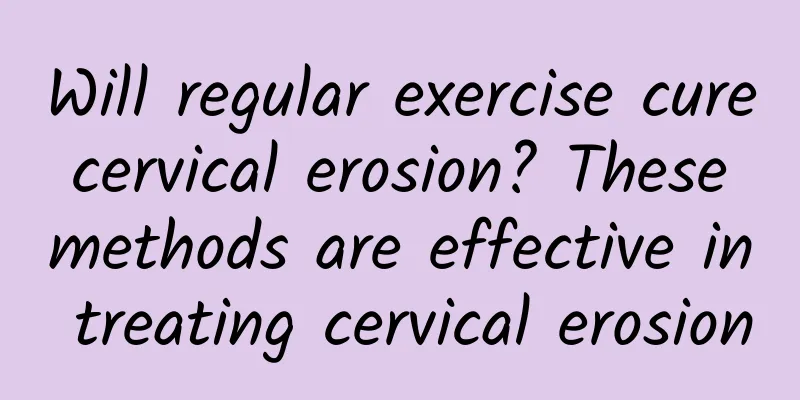Will regular exercise cure cervical erosion? These methods are effective in treating cervical erosion

|
Patients with cervical erosion need to go to the hospital for a detailed examination. The first thing to do is a gynecological examination. The most important thing is to check the size, shape and texture of the cervix, and see if there is any bleeding in the cervix. In addition, it is necessary to do a cervical scraping cytology examination. In serious cases, a colposcopy examination is required, etc. This can fully understand the severity of cervical erosion. For diseases such as cervical erosion, will the patient's condition improve if he exercises regularly? Will regular exercise cure cervical erosion? Regular exercise will not heal cervical erosion on its own. This is because cervical erosion has nothing to do with exercise. Cervical erosion is generally divided into three levels clinically. There are mild, moderate, and severe. Generally, any married woman who has sex will have some inflammation on the cervix. As long as cervical cytology screening is done, there will be mild inflammation and the so-called cervical erosion. However, this situation does not have any symptoms, such as increased secretions, abdominal discomfort, and even sexual pain and discomfort. It can only be discovered during a gynecological examination. Therefore, mild cervical erosion does not require treatment, as long as regular gynecological examinations are conducted every 2-3 years. However, for severe cervical erosion, there are usually symptoms, increased secretions, and even abdominal discomfort, which all require treatment. Generally, Baofukang suppositories are placed in the vagina. Exercise will not have a curative effect. Sexual intercourse must be avoided during treatment, and sexual intercourse can be considered after treatment. Exercise therapy for cervical erosion should be based on the patient's physical condition and illness, and should not be performed arbitrarily. Common methods for treating cervical erosion are: (1) Drug treatment: Suitable for patients with a small erosion area and shallow inflammatory infiltration. Antibiotics can be applied topically, such as metronidazole, sulfonamides, furazolidone, etc. Traditional Chinese medicine is widely used in the treatment of cervical erosion in clinical practice, and the effect is also good. Some prescriptions and formulas are often selected, processed into powder or suppositories, placed on cotton balls, and applied to the eroded surface. Generally, the medicine is applied twice a week. During the treatment, there is more yellow vaginal discharge, but there should be no odor. Treatment usually starts after the menstruation is over, and the medicine is applied continuously for one month, and the use is stopped during the menstrual period. (2) Physical therapy: This is a widely used treatment method with the advantages of short treatment course and good efficacy. It is suitable for patients with large erosion area and deep inflammatory infiltration. Commonly used methods include electric ironing, laser therapy, and cryotherapy. Electric ironing should be performed within 3 to 7 days after the end of menstruation. During treatment, the electric iron head is placed in contact with the eroded surface and slightly pressed, moving back and forth from the inside to the outside until it slightly exceeds the eroded surface. After surgery, 1% gentian violet is applied to the wound surface. The patient will have more vaginal secretions within 2 to 3 days, and there may be a small amount of vaginal bleeding within 2 weeks. After 2 to 3 weeks, the wound surface will shed scabs and the squamous epithelium will begin to repair. Laser therapy uses laser to carbonize and scab the eroded tissue. The scabs will fall off about 3 weeks after surgery, and new squamous epithelium will grow on the wound surface. There will also be a lot of vaginal discharge after laser treatment. Cryotherapy uses liquid nitrogen as a cooling source and uses a rapid cooling device to freeze, necrotize, and fall off the eroded tissue. There is little bleeding after surgery, but there is a lot of vaginal discharge, which generally lasts 2 to 3 weeks. The necrotic tissue fell off in 6 weeks and the wound healed in 8 weeks. Before physical therapy, the vulva, vagina, and cervix should be routinely disinfected. Since there is a large amount of fluid discharge after surgery, care should be taken to keep the vulva clean and dry to prevent infection. Sexual intercourse, bathing in a tub, and vaginal douching are prohibited before the wound is completely healed, which generally takes 4 to 8 weeks. After treatment, check once a month to check the healing of the wound. (3) Surgical treatment: If the above treatments are ineffective, or if there is cervical hypertrophy, or the erosion is deep and extensive, and involves the cervical canal, cervical conization or total hysterectomy may be considered. However, surgical treatment is rarely used nowadays. |
Recommend
What Chinese medicine can be used to treat premature ovarian failure
What Chinese medicine can be used to treat premat...
Expert Answer: What are the causes of ovarian cysts?
Many patients are still unclear about the causes ...
What are the symptoms of uterine fibroids? How to treat uterine fibroids?
Fibroids may appear in a woman's uterus since...
The best time to lose weight during the follicular phase of the menstrual cycle
Summer is the peak season for women to lose weigh...
3 steps to diagnose cervical erosion
Cervical erosion is a gynecological disease that ...
What are the dangers of endometriosis?
The uterus is likened to a woman's "litt...
Eating short ribs at Christmas can hurt your heart as the saturated fat content is off the charts!
Christmas is coming. In addition to exchanging gi...
Will irregular menstruation cause infertility?
Irregular menstruation does not necessarily lead ...
Selling fat! After rapid weight gain or loss, life is very short
The issue of artists gaining or losing weight rap...
What foods are good for uterine fibroids? What foods are good for uterine fibroids?
What foods are good for uterine fibroids? What fo...
Treatment of Bartholinitis in Traditional Chinese Medicine
Feeling itchy and damp in the vulva directly and ...
What women should know about the treatment of cervical hypertrophy
There are many kinds of gynecological diseases in...
How to take the right nutritional supplements to gain muscle and lose fat? Eating "these" can help you accelerate muscle growth and fat loss
Nutritional supplements are an area that many fit...
How long after a miscarriage can I wash my hair? What should I eat to recover quickly after a miscarriage?
Miscarriage is a very helpless thing for women, b...
Do uterine fibroids need to be removed? How big should uterine fibroids be before they need to be removed?
If a woman finds symptoms related to uterine fibr...









